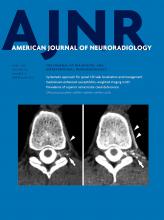Index by author
Najm, M.
- InterventionalOpen AccessClot Burden Score and Early Ischemia Predict Intracranial Hemorrhage following Endovascular TherapyV. Yogendrakumar, F. Al-Ajlan, M. Najm, J. Puig, A. Calleja, S.-I. Sohn, S.H. Ahn, R. Mikulik, N. Asdaghi, T.S. Field, A. Jin, T. Asil, J.-M. Boulanger, M.D. Hill, A.M. Demchuk, B.K. Menon and D. Dowlatshahi on behalf of the INTERRSeCT InvestigatorsAmerican Journal of Neuroradiology April 2019, 40 (4) 655-660; DOI: https://doi.org/10.3174/ajnr.A6009
Narvid, J.
- SpineOpen AccessConvolutional Neural Network–Based Automated Segmentation of the Spinal Cord and Contusion Injury: Deep Learning Biomarker Correlates of Motor Impairment in Acute Spinal Cord InjuryD.B. McCoy, S.M. Dupont, C. Gros, J. Cohen-Adad, R.J. Huie, A. Ferguson, X. Duong-Fernandez, L.H. Thomas, V. Singh, J. Narvid, L. Pascual, N. Kyritsis, M.S. Beattie, J.C. Bresnahan, S. Dhall, W. Whetstone, J.F. Talbott and TRACK-SCI InvestigatorsAmerican Journal of Neuroradiology April 2019, 40 (4) 737-744; DOI: https://doi.org/10.3174/ajnr.A6020
Nicholson, P.J.
- FELLOWS' JOURNAL CLUBSpineOpen AccessSpontaneous Intracranial Hypotension: A Systematic Imaging Approach for CSF Leak Localization and Management Based on MRI and Digital Subtraction MyelographyR.I. Farb, P.J. Nicholson, P.W. Peng, E.M. Massicotte, C. Lay, T. Krings and K.G. terBruggeAmerican Journal of Neuroradiology April 2019, 40 (4) 745-753; DOI: https://doi.org/10.3174/ajnr.A6016
Using spinal MR imaging to dichotomize patients with spontaneous intracranial hypotensioninto spinal longitudinal extradural CSF collection positive and negative populations accurately determines the nature of their underlying CSF leak (mechanical dural tear versus CSF venous fistula or nerve root sleeve leak), correctly predicts in whom autologous nondirected and directed epidural blood patch may work and in whom it will fail, and finally prescribes the positioning (prone versus decubitus) for subsequent dynamic myelography providing the most efficient pathway to definitive leak localization and repair. Using this systematic approach, the authors have been able to identify the exact site of CSF leakage in 27 (87%) of 31 consecutive patients referred to their institution with MR imaging evidence of SIH.
Nogueira, R.G.
- InterventionalYou have accessAneurysm Remnants after Flow Diversion: Clinical and Angiographic OutcomesT.P. Madaelil, J.A. Grossberg, B.M. Howard, C.M. Cawley, J. Dion, R.G. Nogueira, D.C. Haussen and F.C. TongAmerican Journal of Neuroradiology April 2019, 40 (4) 694-698; DOI: https://doi.org/10.3174/ajnr.A6010
Nunes, R.H.
- EDITOR'S CHOICEAdult BrainOpen AccessGadolinium-Enhanced Susceptibility-Weighted Imaging in Multiple Sclerosis: Optimizing the Recognition of Active Plaques for Different MR Imaging SequencesL.L.F. do Amaral, D.C. Fragoso, R.H. Nunes, I.A. Littig and A.J. da RochaAmerican Journal of Neuroradiology April 2019, 40 (4) 614-619; DOI: https://doi.org/10.3174/ajnr.A5997
The authors analyzed the accuracy of gadolinium SWI for detecting the imaging evidence of active inflammation on MS plaques when a BBB dysfunction was demonstrated by a focal gadolinium-enhanced lesion and compared this technique with gadolinium-enhanced T1 spin-echo and T1 spin-echo with magnetization transfer contrast sequences. Differences in BBB dysfunction were evident in the 103 patients among gadolinium SWI, gadolinium T1 spin-echo, and gadolinium T1 magnetization transfer contrast. Gadolinium T1 magnetization transfer contrast demonstrated the highest number of active demyelinating plaques. Gadolinium SWI was highly correlated with gadolinium T1 magnetization transfer contrast in depicting acute demyelinating plaques and these techniques provided better performance compared with gadolinium T1 spin-echo.








